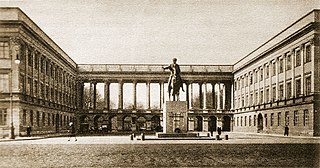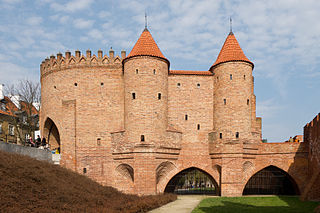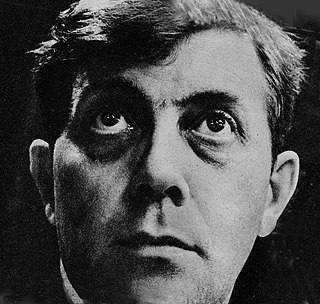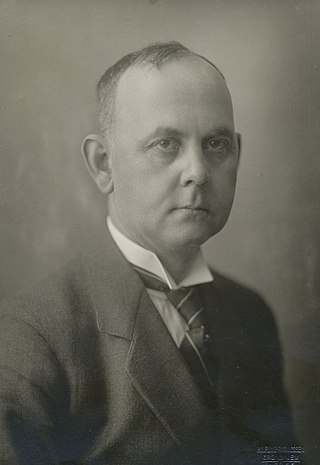
Kenzō Tange was a Japanese architect, and winner of the 1987 Pritzker Prize for Architecture. He was one of the most significant architects of the 20th century, combining traditional Japanese styles with modernism, and designed major buildings on five continents. His career spanned the entire second half of the twentieth century, producing numerous distinctive buildings in Tokyo, other Japanese cities and cities around the world, as well as ambitious physical plans for Tokyo and its environments.

Constantinos A. Doxiadis, often cited as C. A. Doxiadis, was a Greek architect and urban planner. During the 1960s, he was the lead architect and planner of Islamabad, which was to serve as the new capital city of Pakistan. He was later known as the father of ekistics, which concerns the multi-aspect science of human settlements.

The Tomb of the Unknown Soldier is a monument in Warsaw, Poland, dedicated to the unknown soldiers who have given their lives for Poland. It is one of many such national tombs of unknowns that were erected after World War I, and the most important such monument in Poland.

The Saxon Palace was one of the most distinctive buildings in Warsaw, Poland before World War II. It was destroyed by German armed forces after the fall of the Warsaw Uprising in 1944 as part of their planned destruction of Warsaw and not rebuilt since. Ground work commenced in August 2022, after the Polish Government announced a plan regarding reconstruction of the building. It is expected to be completed by 2030.

Stanisław Żaryn was an architect, urbanist, historian and academic teacher who significantly contributed to the process of the reconstruction of historical Polish architecture after its destruction by the Germans during WWII. He was born in Warsaw to Eugenia and Franciszek Zaryn.

The Warsaw Barbican is a barbican in Warsaw, Poland, and one of few remaining relics of the complex network of historic fortifications that once encircled Warsaw. Located between the Old and New Towns, it is a major tourist attraction.

The destruction of Warsaw was Nazi Germany's razing of the city in late 1944, after the 1944 Warsaw Uprising of the Polish resistance. The uprising infuriated German leaders, who decided to destroy the city in retaliation.

Wiktor Zin was a Polish architect, graphic artist, professor, architectural preservationist, cultural activist, and promoter of Polish history and culture.

Czesław Bobrowski was a Polish economist. In postwar Poland, he was a director of Central Planning Office from 1945–1948, author of the Three-Year Plan. He was also a member of the State National Council (1945–1947) and Parliament (1947–1948).
The 1963 Skopje earthquake was a 6.1 moment magnitude earthquake which occurred in Skopje, SR Macedonia, then part of the SFR Yugoslavia, on July 26, 1963, which killed over 1,070 people, injured between 3,000 and 4,000 and left more than 200,000 people homeless. About 80 percent of the city was destroyed.

Stanisław Jankowski was an SOE agent and Polish resistance fighter during World War II, and an architect thereafter, who played a prominent role in the post-war reconstruction of Warsaw.
Percy Edwin Alan Johnson-Marshall CMG was a British urban designer, regional planner and academic. Born in India, he was educated at Liverpool University, and worked initially with local authorities in the south of England. In 1959, he took a post as senior lecturer at the University of Edinburgh, and was appointed Professor of Urban Design and Regional Planning in 1964.

The groups of people who have settled or controlled the territory of modern-day North Macedonia have influenced the country in many ways, one of the most visible being architecture. These groups of people include the Paionians, Illyrians, Ancient Macedonians, Romans, Byzantines, Bulgarians, Serbs, Ottomans, Yugoslavs, and ethnic Macedonians.

The Pabst Plan was a Nazi German urban plan to reconstruct the city of Warsaw as a Nazi model city. Named after its creator Friedrich Pabst, the Nazis' "Chief Architect for Warsaw", the plan assumed that Warsaw, the historical capital of Poland and a city of 1.5 million inhabitants, would be completely destroyed and rebuilt as a small German town of not more than 130,000 inhabitants.
Mimoza Nestorova-Tomić is a Macedonian architect, planner, and urban designer, who played a significant role in the masterplan and reconstruction of Skopje after the 1963 earthquake. Initially she worked specifically in the team for social planning with Polservice, the Polish consultants, alongside Kenzo Tange, the winner of a United Nations international competition for the reconstruction of Skopje. In the period 1986-1989 Nestorova-Tomić was director of the director and design architect of the City Institute for Planning in Skopje. As a female architect working within socialist Yugoslavia, Nestorova-Tomić presents a different trajectory to her counterparts in the West.

Slavko Brezoski was a Macedonian architect, urban planner, painter, writer and educator known for his works in the genre of modern architecture realised during the middle of the 20th Century in North Macedonia, Serbia, Croatia, Brazil and Libya. He was professor and Dean at the Faculty of Architecture at the Ss. Cyril and Methodius University of Skopje.

Sverre Pedersen was a Norwegian architect and urban planner.
Urban planning in Nazi Germany, the urban design and planning concepts used and promoted by the Third Reich (1933–1945), was heavily influenced by modernist planning and involved totalitarian methods to enforce Nazi ideology on its native and conquered populations.

Plan for Skopje 1963 was the urban and architectural plan put forward to rebuild the city of Skopje following the 1963 Skopje earthquake. The plan was organised between 1963 and 1966 by the government of Yugoslavia and the United Nations. The rebuilding of the city attracted large international attention, this led to the involvement of a large number of high-profile architects. The UN invited Kenzo Tange and his team to participate in an international competition for the urban design of the city centre in 1965; as one of several Yugoslav and international architecture teams. Architects that participated in the plan include Greek architect Constantinos Doxiadis and Polish architect Adolf Ciborowski. Dutch architects Van den Broek and Jaap Bakema. Luigi Piccinato (Italy) and Maurice Rotival (USA). Yugoslav participants included Aleksandar Dordevik, Slavko Brezoski, Edvard Ravnikar, Radovan Miščević and Fedor Wenzler.

Helena Kurkiewicz-Morsztynkiewiczowa was a Polish architect and urban planner. During World War I, she was active in a Polish military organization.

















